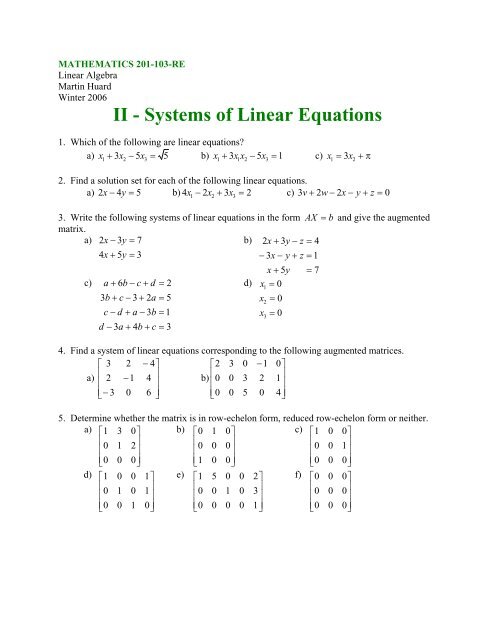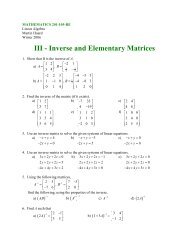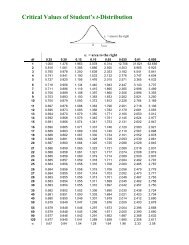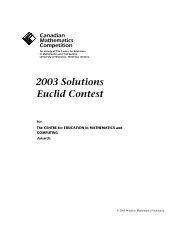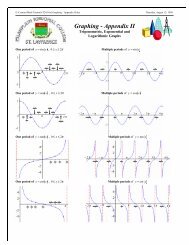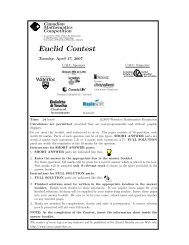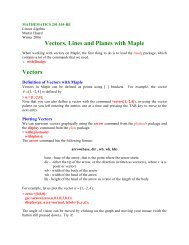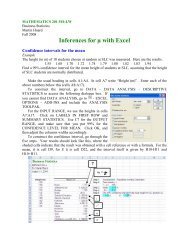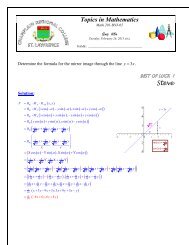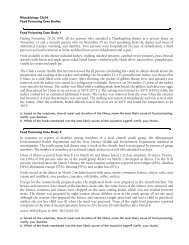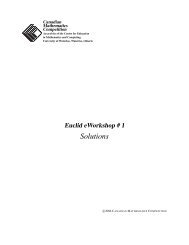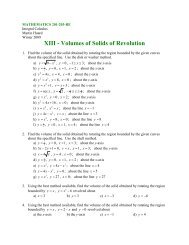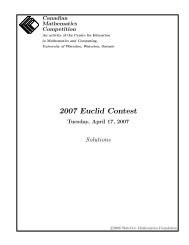II - Systems of Linear Equations - SLC Home Page
II - Systems of Linear Equations - SLC Home Page
II - Systems of Linear Equations - SLC Home Page
You also want an ePaper? Increase the reach of your titles
YUMPU automatically turns print PDFs into web optimized ePapers that Google loves.
MATHEMATICS 201-103-RE<strong>Linear</strong> AlgebraMartin HuardWinter 2006<strong>II</strong> - <strong>Systems</strong> <strong>of</strong> <strong>Linear</strong> <strong>Equations</strong>1. Which <strong>of</strong> the following are linear equations?a) x + x − 5x5 b) x + x x − 5x1 c) x1= 3x2+ π132 3=131 2 3=2. Find a solution set for each <strong>of</strong> the following linear equations.a) 2 x − 4y= 5 b) x − 2x+ 3x2 c) 3 v + 2w− 2x− y + z = 041 2 3=3. Write the following systems <strong>of</strong> linear equations in the form AX = b and give the augmentedmatrix.a) 2x − 3y= 7b) 2x+ 3y− z = 44x+ 5y= 3− 3x− y + z = 1c)a + 6b− c + d = 2d)3b+ c − 3 + 2a= 5c − d + a − 3b= 1d − 3a+ 4b+ c = 3x + 5yx = 04. Find a system <strong>of</strong> linear equations corresponding to the following augmented matrices.⎡ 3 2 − 4⎤⎡23 0 −10⎤a)⎢⎥⎢2 −14⎥b)⎢⎥⎢0 0 3 2 1⎥⎢⎣− 3 0 6 ⎥⎦⎢⎣0 0 5 0 4⎥⎦5. Determine whether the matrix is in row-echelon form, reduced row-echelon form or neither.a) ⎡1 3 0⎤b) ⎡0 1 0⎤c) ⎡10 0⎤⎢ ⎥⎢0 1 2⎢ ⎥⎥⎢0 0 0⎢ ⎥⎥⎢0 0 1⎥⎢⎣0 0 0⎥⎦⎢⎣1 0 0⎥⎦⎢⎣0 0 0⎥⎦d) ⎡1 0 0 1⎤e) ⎡1 5 0 0 2⎤f) ⎡00 0⎤⎢ ⎥⎢0 1 0 1⎢⎥⎥ ⎢0 0 1 0 3⎢ ⎥⎥ ⎢0 0 0⎥⎢⎣0 0 1 0⎥⎦⎢⎣0 0 0 0 1⎥⎦⎢⎣0 0 0⎥⎦xx123= 0= 0= 7
Math 105<strong>II</strong> – <strong>Systems</strong> <strong>of</strong> <strong>Linear</strong> <strong>Equations</strong>6. Solve the following systems <strong>of</strong> linear equations using Gaussian elimination.a) x + 2y= 7 b) x − 3y= 5c) − x + 2y= 1.5d)g)2x+ y = 8− 3x + 5y= −2e)3x+ 4y= 4− 2x+ 6y= −10x − 3x= −2f)− 2x= 54x− 8y= 32 2x1+ 2x2+ x3= 4x + 2y+ z = 8 h) 2x + y + 2z= 7− 3x− 6y− 3z= −21x + y + 2z= 4j) 3x + 3y + 12z=x + y + 4z= 22x + 5y + 20z= 10− x + 2y + 8z=6413x+ x122x − 2y − 4z= 4k) 2x − 3y + 4z − t =336x + y − 3z + 2t=−2x − 4y + 7z − 3t=4x − y − 2z + 3t=822x− 4y= 3x + x − 5x= 31x12− 2x= 12x1− x2− x3= 0i) x − 2y + 4z=3362x − 4y + 10z= 18− 3x + 6y − 9z= −97. Solve the systems <strong>of</strong> linear equations in 6 using the Gauss-Jordan method.8. Solve the following homogeneous systems <strong>of</strong> linear equations by any method.a) x− y+ z = 0x + x + x = 0 c) x + 2y + z + w=0x+ y = 0x+ 2y− z = 0b)1 2 3−2x −2x − 2x= 01 2 33x + 3x + 3x= 01 2 39. Solve the following systems on nonlinear equations.a)1 1 1x− 2y+z= 1b) x − z =−11 1 12x+ 2y− 3z= 101 13x+z= 8y2x + 2e + 5 z = 21− + =yx e zx − y + w=0y − z + 2w=010. Find values <strong>of</strong> a, b and c (if possible) such that the given system <strong>of</strong> linear equations hasi) a unique solutionii) no solutioniii) an infinite number <strong>of</strong> solutionsa) x + y + = 2b) x + y + = 0xy + z = 2+ z = 2ax + by + cz = 0xy + z = 0+ z = 0ax + by + cz = 04Winter 2006 Martin Huard 2
Math 105<strong>II</strong> – <strong>Systems</strong> <strong>of</strong> <strong>Linear</strong> <strong>Equations</strong>11. For which values <strong>of</strong> a will the following system <strong>of</strong> linear equations havex + 2y − 3z= 4i) a unique solutionii) no solutioniii) an infinite number <strong>of</strong> solutions3x − y + 5z=2( )4x + y + a − 14 z = a+212. For which values <strong>of</strong> k will the following system <strong>of</strong> linear equations havex − y + 2z= 0y − z = k− x + 2y − 3z = 1i) a unique solutionii) no solutioniii) an infinite number <strong>of</strong> solutions2213. For which values <strong>of</strong> a will the following system <strong>of</strong> linear equations have2ax+ 2y+ 2z=0x + y + 2z= 1− x + y + 2az= 3i) a unique solutionii) no solutioniii) an infinite number <strong>of</strong> solutions14. What condition on a, b and c would ensure that the following system <strong>of</strong> linear equations isconsistent?2x + 3y − 5z = a5x − 2y + 3z = bx − 8y + 13z = cWinter 2006 Martin Huard 3
Math 105<strong>II</strong> – <strong>Systems</strong> <strong>of</strong> <strong>Linear</strong> <strong>Equations</strong>ANSWERS1. a, c2. a)( 5 22, tt, ,2 2 4 3 3 3 3, , , ,3. a) ⎡2 −3⎤⎡x⎤ ⎡7⎤⎡2 −3 7⎤⎢ =4 5⎥⎢y⎥ ⎢⎣ ⎦⎣ ⎦ ⎣3⎥⎢⎦4 5 3⎥⎣ ⎦b) ⎡ 2 3 −1⎤⎡x⎤ ⎡4⎤⎡ 2 3 −1 4⎤⎢−3 − 1 1⎥⎢y⎥=⎢1⎥⎢⎢3 1 1 1⎥⎥⎢ ⎥ ⎢ ⎥⎢− −⎥⎢⎣ 1 5 0 ⎥⎢ ⎦⎣z⎥⎦ ⎢⎣7⎥⎦⎢⎣1 5 0 7⎥⎦c) ⎡ 1 6 −1 1 ⎤⎡a⎤ ⎡2⎤⎡ 1 6 −1 1 2⎤⎢2 3 1 0⎥⎢b⎥ ⎢8⎥ ⎢⎢ ⎥⎢ ⎥ = ⎢ ⎥2 3 1 0 8⎥⎢⎥⎢ 1 −3 1 −1⎥⎢c⎥ ⎢1⎥⎢ 1 −3 1 −1 1⎥⎢ ⎥⎢ ⎥ ⎢ ⎥ ⎢⎥⎣−3 4 1 1 ⎦⎣d⎦ ⎣3⎦⎣−3 4 1 1 3⎦d) ⎡1 0 0⎤⎡x1⎤ ⎡0⎤⎡1 0 0 0⎤⎢0 1 0⎥⎢x⎥ ⎢ ⎥2 =⎢0⎢⎢ ⎥⎢ ⎥ ⎥0 1 0 0⎥⎢ ⎥⎢⎣0 0 1⎥⎢ ⎦⎣x⎥ ⎢⎣ ⎥3 ⎦ 0⎦⎢⎣0 0 1 0⎥⎦1 3+ ) b) ( + 1s−t s t ) c) ( − 2 d + 2 c+ 1 b−1 a d c b a)4. a) 3x+ 2y= −4 b) 2x + 3y − w=02x− y = 43z+ 2w=1− 3x= 65z= 45. Row-echelon form : a, c, d, e, f Reduced row-echelon form : c, d, f6. a) x = 3 , y = 2 b) x = 5 + 3t, y = tc) No solutiond) No solution e) 1, x 3 2= − , x3= 2 f) x1 = 1+2t, x2 = 2 + 3t , x3= tg) No solution h) x = 3,y = 1− 2t, z = t i) x = 2t− 6, y = t,z = 3j) x = 0, y = 2 − 4t, z = tk) x = s− r, y = 2s−r−2, z = s, t = r8. a) x = 0, y = 0, z = 0 b) x1= −− t s, x2= s , x3= t3 1 3c) x =− r , y =− r,z = r, w=r2 2 219. a) = , 2, 3= =−1 b) 2, 0, 910. a) (i) a+ b+ c= 0 ii) a+ b+ c≠0iii) Neverb) (i) always ii) never iii) never11. i) a ≠± 4ii) a =− 4 iii) a = 412. i) never ii) k ≠± 1 iii) k = ± 113. i) a ≠−1,0,2ii) a =− 1,0 iii) a = 214. 2a− b+ c=0Winter 2006 Martin Huard 4


